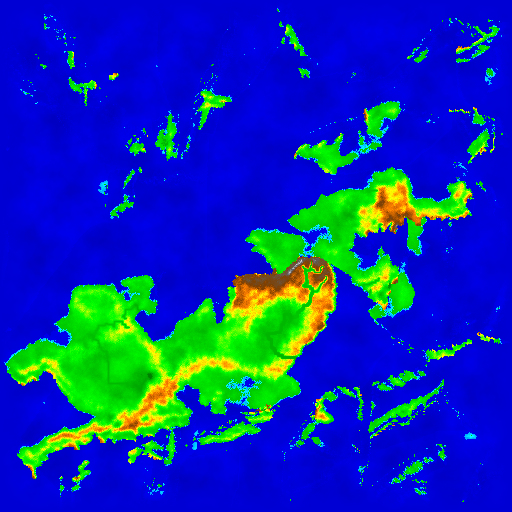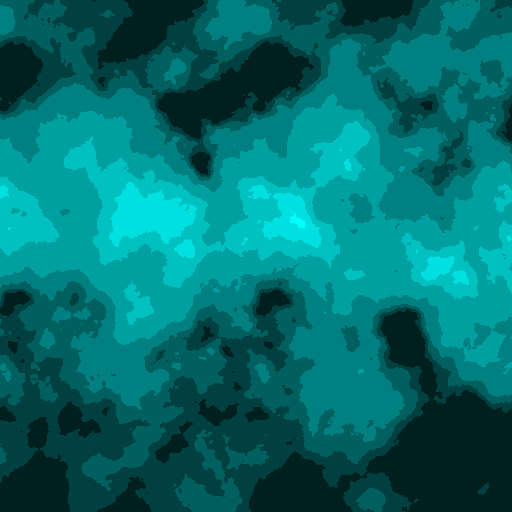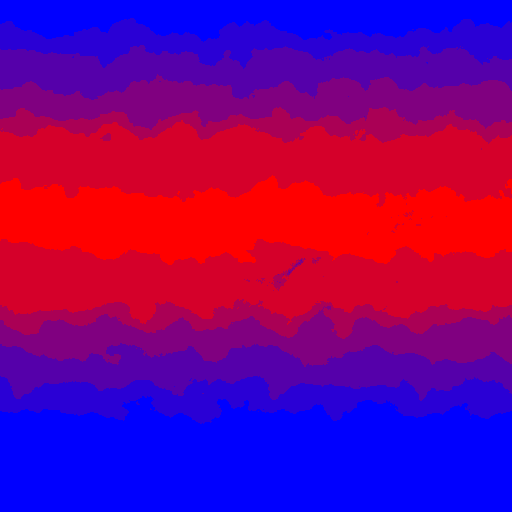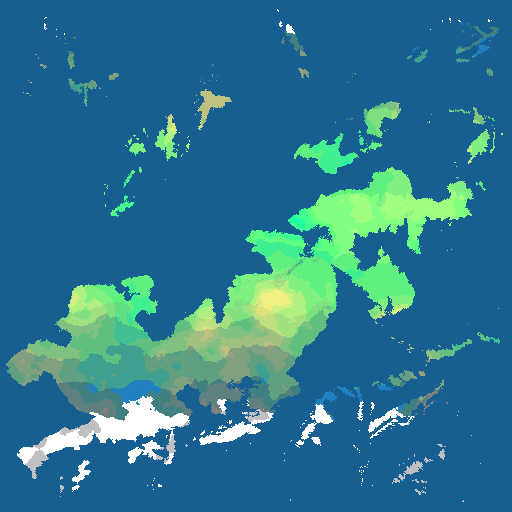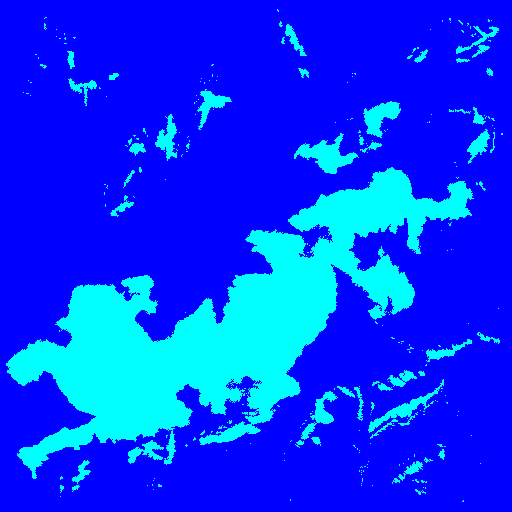| Branch | AppVeyor | CodeQL | codecov.io | Docs |
|---|---|---|---|---|
master |
||||
develop |
The current stable version is 0.19.0
WorldEngine C++ is based on WorldEngine by Bret Curtis and Federico Tomassetti. The C++ project grew out of a desire to link a native WorldEngine library into an application, instead of bringing in the Python runtime. The goal of WorldEngine C++ is to maintain as much functionality and compatibility as possible. While random number generation differs between this and the original project resulting in new worlds, the application produces compatible world files and images using the same algorithms. You can find the original project here:
You can generate the data for your own world, including a number of images (heightmap, biomes, etc.).
For example:
worldengine world -s 1 -n seed1Worlds are generated using plate simulations, erosion, rain shadows, Holdridge life zones model and plenty of other phenomenons.
The created world can be used for simulating the evolution of a civilization (see project civs).
It is also possible to generate additional maps, for example an ancient looking map:
worldengine ancient_map -w seed1.worldThe manual for WorldEngine C++: http://worldengine-cpp.readthedocs.io/en/latest/
We would love to see WorldEngine C++ used together with other tools. Worlds generated by WorldEngine C++ can be loaded into applications using WorldEngine C++ itself as a library. WorldEngine C++ maintains interoperability with the original WorldEngine.
Worlds can be saved using the protobuf format or hdf5, for which there are libraries in several languages. We keep working on supporting more formats and always interested in ways to improve interoperability.
Releases for Windows and Linux are available on the releases page.
An experimental (and limited!) GUI is available as a separate project for the original WorldEngine project: https://github.com/Mindwerks/worldengine-gui.
In order to build the software, you will need the following installed:
- CMake
- Python
First, run the setup script of your choosing. Enter the build directory, and run "cmake --build . Configuration=<Debug|Release>".
The application produces a binary format with all the data of the generated world and a set of images. A sample set of data that the application produces is below.
There are several optional outputs and many options to control the result. The manual is your friend!
worldengine [<operation> [<file>]] [<options>]
For details about all the possible options please refer to the manual.
For example these commands:
worldengine -s 4 -n an_example -q 25 -x 2048 -y 2048
Produces this output
WorldEngine C++ - A World Generator (version 0.19.0)
----------------------------------------------------
Operation : world generation
Seed : 4
Name : an_example
Width : 256
Height : 256
Number of plates : 25
World format : protobuf
Black and white maps : false
Step : full
Grayscale heightmap : false
Icecaps heightmap : false
Rivers map : false
Scatter plot : false
Satellite map : false
World map : false
Elevation map : false
Elevation shadows : false
Fade borders : true
Temperature ranges : 0.126 0.235 0.406 0.561 0.634 0.876
Humidity ranges : 0.059 0.222 0.493 0.764 0.927 0.986 0.998
Gamma value : 1.25
Gamma offset : 0.2
[2021-05-15 18:16:05.715221] [0x000050b0] [info] Starting world generation...
[2021-05-15 18:18:23.688395] [0x000037e0] [info] Temperature simulation start
[2021-05-15 18:18:23.712400] [0x000037e0] [info] Temperature simulation finish
[2021-05-15 18:18:23.712400] [0x000037e0] [info] Precipitation simulation start
[2021-05-15 18:18:23.731404] [0x000037e0] [info] Precipitation simulation finish
[2021-05-15 18:18:23.731404] [0x000037e0] [info] Erosion simulation start
[2021-05-15 18:18:23.777419] [0x000037e0] [info] Erosion simulation finish
[2021-05-15 18:18:23.777419] [0x000037e0] [info] Watermap simulation start
[2021-05-15 18:18:23.802430] [0x000037e0] [info] Watermap simulation finish
[2021-05-15 18:18:23.802430] [0x000037e0] [info] Irrigation simulation start
[2021-05-15 18:18:23.853441] [0x000037e0] [info] Irrigation simulation finish
[2021-05-15 18:18:23.853441] [0x000037e0] [info] Humidity simulation start
[2021-05-15 18:18:23.857443] [0x000037e0] [info] Humidity simulation finish
[2021-05-15 18:18:23.857443] [0x000037e0] [info] Permeability simulation start
[2021-05-15 18:18:23.868445] [0x000037e0] [info] Permeability simulation finish
[2021-05-15 18:18:23.868445] [0x000037e0] [info] Biome simulation start
[2021-05-15 18:18:23.869445] [0x000037e0] [info] Biome simulation finish
[2021-05-15 18:18:23.869445] [0x000037e0] [info] Icecap simulation start
[2021-05-15 18:18:23.871445] [0x000037e0] [info] Icecap simulation finish
[2021-05-15 18:18:23.871445] [0x000037e0] [info] Producing output
[2021-05-15 18:18:23.886449] [0x000037e0] [info] World data saved in ./an_example.world
[2021-05-15 18:18:23.902453] [0x000037e0] [info] Ocean image generated in ./an_example_ocean.png
[2021-05-15 18:18:23.920456] [0x000037e0] [info] Precipitation image generated in ./an_example_precipitation.png
[2021-05-15 18:18:23.937460] [0x000037e0] [info] Temperature image generated in ./an_example_temperature.png
[2021-05-15 18:18:23.954512] [0x000037e0] [info] Biome image generated in ./an_example_biome.png
[2021-05-15 18:18:23.973517] [0x000037e0] [info] Simple elevation image generated in ./an_example_elevation.png
[2021-05-15 18:18:23.974517] [0x000037e0] [info] Done
Larger maps can take quite some time. To generate an ancient map out of this example:
worldengine ancient_map -w an_example.world
A 2048x2048 ancient map could look like this:
The world generation algorithm goes through different phases:
- Plates simulation: it is the best way to get proper mountain chains. For this plate-tectonics is used
- Noise techniques are used at different steps, using OpenSimplex noise
- Precipitations are calculated considering latitude and rain shadow effects
- Erosion is calculated
- Humidity in each zone is calculated
- Terrain permeability is calculated
- Biomes are calculated using the Holdridge life zones model
This project is maintained by Dan Paulat
All contributions, questions, ideas are more than welcome!
We would like to thank you great people who helped us while working on WorldEngine and the projects from which it was derived:
-
Bret Curtis and Federico Tomassetti, contributing the original WorldEngine project, and its many contributors.
-
Evan Sampson contributed the amazing implementation of the Holdridge life zones model and improved a lot the ancient-looking-map, biome, precipitation and temperature generators. Thanks a million!
-
Ryan contributed the Windows binary version and discussed Lands on Reddit bringing a lot of users. Thanks a million!
-
stefan-feltmann made Lands depends on pillow instead that on PIL (which is deprecated). This could also help when moving to Python 3. Thanks a million!
-
Russell Brinkmann helped saving the generation parameters in the generated world (so that we can use it to generate the same world again, for example), improved the command line options and added tracing information (useful for understanding the performance of the various generation steps)
-
Joshua Coppola implemented the satellite view. Thanks a lot, it looks gorgeous!
-
Stephan made WorldEngine make heavy use of numpy, helping to speed up the generation. He also made world-generation much more reproducible and helped improve compatibility with Python 3.
-
Alex made things generally run faster and look cleaner by better employing numpy.
WorldEngine has been created by merging Lands and WorldSynth. Last Lands version was 0.5.3, last WorldSynth version: 0.12, first WorldEngine version has been 0.18. WorldEngine C++ 0.19.0 was created based on WorldEngine 0.19.0.
WorldEngine C++ is available under the MIT License. You should find the LICENSE in the root of the project.

